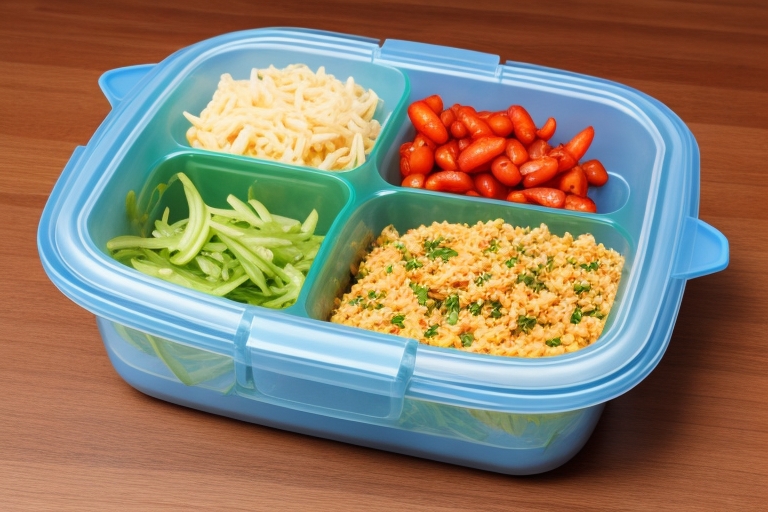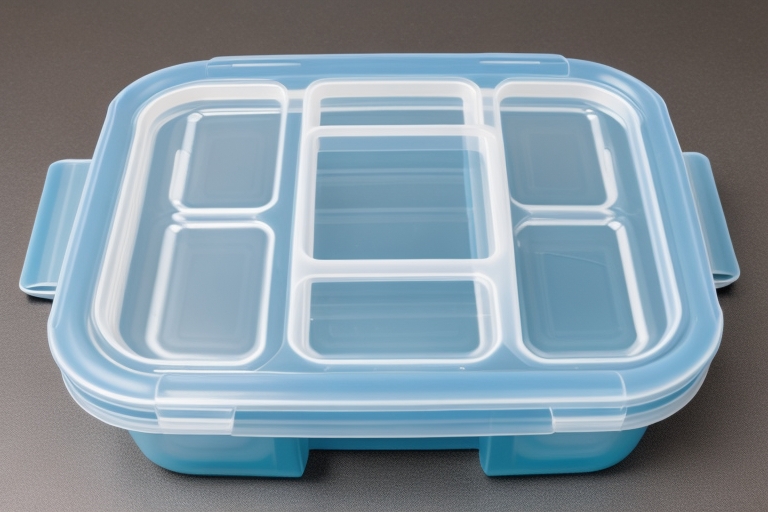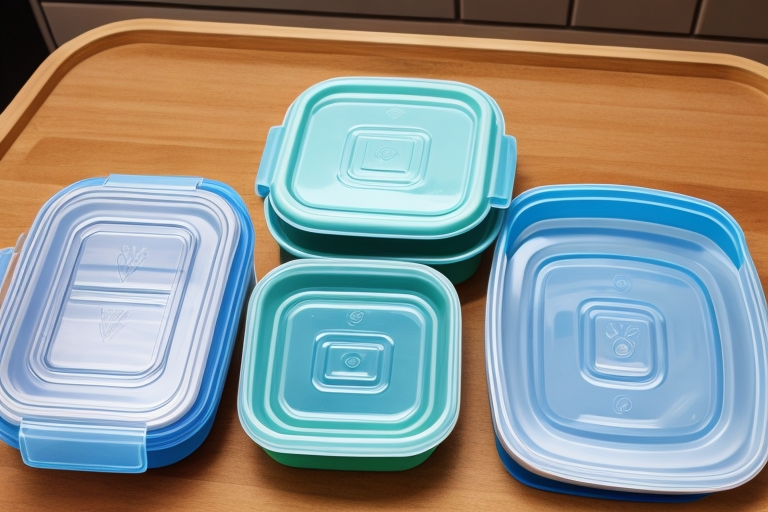
Plastic food containers have become ubiquitous in our daily lives, offering unparalleled convenience in storing, transporting, and reheating our meals. From takeout containers to reusable storage bins, these lightweight and durable vessels have become an integral part of modern food culture. However, the convenience they provide may come at a cost to our health.
In this blog post, we’ll delve into the potential risks associated with using plastic food containers. While these containers offer practical solutions for our on-the-go lifestyle, there are concerns about the impact of certain chemicals found in plastics on human health. Join me as we explore the facts and myths surrounding plastic food containers, aiming to make informed choices about the containers we use daily.
Types of Plastic Food Containers
Let’s break down the types of plastic commonly used for food containers:
- Polyethylene Terephthalate (PET):
- Characteristics: PET is a lightweight, clear, and durable plastic. It is commonly used for single-use water bottles, salad dressing containers, and peanut butter jars.
- Uses: PET is popular for its transparency and resistance to moisture and gases, making it suitable for beverages and food products.
- High-Density Polyethylene (HDPE):
- Characteristics: HDPE is a sturdy and opaque plastic with high resistance to chemicals. It’s often used for milk jugs, detergent bottles, and some food containers.
- Uses: HDPE’s strength and chemical resistance make it ideal for packaging various liquids and food items.
- Polycarbonate:
- Characteristics: Polycarbonate is a clear and tough plastic, known for its shatter-resistant properties. It is used in reusable water bottles, baby bottles, and some food storage containers.
- Uses: The durability of polycarbonate makes it suitable for products that require impact resistance, but concerns have been raised about the potential leaching of bisphenol A (BPA) from this plastic.
Now, let’s touch upon the concerning chemicals:
- Bisphenol A (BPA):
- Presence: BPA is commonly found in polycarbonate plastics and epoxy resins used to line some metal cans.
- Potential Health Effects: Studies suggest that BPA may disrupt the endocrine system and have hormonal effects, raising concerns about its impact on reproductive health and development.
- Phthalates:
- Presence: Phthalates are often added to plastics to increase flexibility and durability. They can be found in various types of plastic, including PVC.
- Potential Health Effects: Some phthalates are known to be endocrine disruptors, and exposure has been linked to developmental and reproductive issues.
As we continue our exploration, it’s essential to consider how these different plastics and the associated chemicals might affect our health over time. Stay tuned for more insights!
Potential Health Risks

Let’s delve into the potential health risks associated with plastic food containers:
- Leaching of Harmful Chemicals:
- Plastic containers can release harmful chemicals into the food or beverages they hold, especially when exposed to heat or acidic conditions. High temperatures, such as microwaving or dishwashing, can accelerate this process, leading to the transfer of chemicals from the plastic to the consumables.
- Bisphenol A (BPA) Exposure:
- BPA, commonly found in polycarbonate plastics, is a known endocrine disruptor. When ingested, BPA can mimic hormones in the body, potentially leading to hormonal imbalances. Research has linked BPA exposure to various health concerns, including reproductive issues, developmental problems, and an increased risk of certain cancers.
- Phthalate Concerns:
- Phthalates, added to plastics for flexibility, are another group of chemicals raising health concerns. These compounds have been associated with endocrine disruption, affecting hormone balance. Prenatal exposure to phthalates has been linked to developmental issues in children, and some studies suggest potential connections to obesity and diabetes.
- Long-term Health Impacts:
- The cumulative effect of prolonged exposure to these chemicals is a growing concern. While individual instances of exposure may seem minor, the constant use of plastic food containers over time may contribute to a gradual build-up of these harmful substances in the body, potentially increasing the risk of adverse health effects.
As consumers, it’s crucial to be aware of the materials used in food containers and take steps to minimize potential risks. Opting for alternatives like glass, stainless steel, or BPA-free plastics can be a proactive measure in reducing exposure to these potentially harmful substances. In the next segment, we’ll explore practical tips for making safer choices in our daily use of food containers.
How Does Plastic Interact With Food?
The interaction between plastic and food is a complex process influenced by various factors, including the type of plastic, temperature, and duration of contact. Here’s a breakdown of how plastic interacts with food:
- Leaching of Chemicals:
- Over time, plastic containers can release chemicals into the food they hold, a process known as leaching. This is more likely to occur when plastic is exposed to heat, acidic substances, or high-fat foods. Leaching is a concern because it can introduce potentially harmful chemicals into the consumables.
- Temperature Influence:
- Temperature plays a crucial role in the interaction between plastic and food. High temperatures, such as those reached during microwaving or dishwashing, can accelerate the release of chemicals from the plastic. It’s advisable to avoid using plastic containers in ways that expose them to extreme temperatures.
- Plastic Types Matter:
- Different types of plastics behave differently. For instance, plastics containing bisphenol A (BPA), such as polycarbonate, have been associated with hormone disruption. Understanding the type of plastic used in your containers can help you make informed choices about their suitability for specific foods and uses.
- Duration of Contact:
- The longer food is in contact with plastic, the greater the potential for chemical transfer. This is why it’s essential to consider the intended use of plastic containers. While a brief encounter may have minimal impact, prolonged storage or repeated use can increase the risk of chemical migration.
- Packaging Influence:
- Plastic used in packaging, such as cling wrap or plastic bags, can also interact with food. This is particularly relevant when storing foods with high fat content, as some chemicals are more soluble in fats and oils.
- Variability in Regulations:
- Regulations regarding the safety of plastic food containers can vary across regions. It’s crucial to be aware of local guidelines and standards to ensure that the plastics used comply with safety regulations.
The interaction between plastic and food is a dynamic process influenced by several factors. To minimize potential risks, it’s advisable to choose food containers made from safer materials like glass, stainless steel, or silicone, especially when dealing with hot or acidic foods. Understanding the characteristics of different plastics and being mindful of how you use them can contribute to healthier food storage practices.
Safer Alternatives to Plastic Food Containers

Let’s explore some safer alternatives to plastic food containers:
- Glass Containers:
- Material: Glass containers are made from natural materials and are inert, meaning they don’t leach harmful chemicals into your food.
- Benefits: Glass is non-porous and resistant to stains and odors. It’s also versatile, as it can be used for both cold and hot foods. Additionally, glass containers are transparent, allowing you to easily identify the contents.
- Stainless Steel Containers:
- Material: Stainless steel is a durable and non-reactive material, making it an excellent choice for food storage.
- Benefits: Stainless steel containers are resistant to corrosion, do not leach harmful substances, and can withstand high temperatures. They are ideal for both short-term and long-term food storage and are often lightweight and easy to clean.
- Silicone Containers:
- Material: Silicone is a flexible and heat-resistant material commonly used in food storage products.
- Benefits: Silicone containers are free from harmful chemicals like BPA and phthalates. They are also microwave and dishwasher safe. The flexibility of silicone makes it convenient for packing and storing various types of food.
- Bamboo Containers:
- Material: Bamboo is a renewable and biodegradable material gaining popularity in the food container market.
- Benefits: Bamboo containers are lightweight, durable, and eco-friendly. They are a great alternative for those looking to reduce their environmental impact while avoiding potential health risks associated with certain plastics.
Availability and Affordability:
- Many of these alternatives are widely available in the market, ranging from specialty kitchen stores to mainstream retailers. The growing awareness of health and environmental concerns has led to an increased variety of options.
- While some alternatives may have a higher upfront cost than certain plastic containers, their durability and longevity often make them a cost-effective choice in the long run.
By choosing these alternatives, you not only prioritize your health but also contribute to a more sustainable and eco-friendly approach to food storage. In the next segment, we’ll explore practical tips for making the switch to safer containers seamlessly. Stay tuned for some actionable advice!
FAQs
- Are plastic food containers safe for storing food?
- It depends on the type of plastic. Look for containers labeled as “food-safe” or with recycling codes 1, 2, 4, or 5, as they are generally considered safe for food storage.
- What plastics should I avoid for food containers?
- Avoid using containers with recycling codes 3 (polyvinyl chloride or PVC) and 7 (often mixed or unclear plastics). These may contain harmful chemicals that can leach into your food.
- Can plastic containers leach harmful chemicals into food?
- Yes, some plastics can release harmful substances, especially when exposed to heat or acidic foods. Choose containers designed for food storage and follow recommended usage guidelines to minimize the risk.
- How should I safely use plastic food containers?
- Avoid microwaving plastic containers unless they are labeled as microwave-safe. Hand wash them with mild detergent instead of using a dishwasher, as harsh detergents and high temperatures can degrade the plastic over time.
- Are there alternative materials to plastic for food storage?
- Yes, consider using glass, stainless steel, or silicone containers as alternatives to plastic. These materials are generally considered safer and more durable for food storage.

Pingback: Which Food Container is Suitable for Transporting Food?
Pingback: Is it better to store cookies in tins or plastic containers?